How to Unblock a Toilet
With or Without a Plunger
A blocked toilet is always an unnecessary annoyance that will need sorting out sooner rather than later. Most people aren’t familiar with the different techniques they could try themselves before calling out a plumber, many of which can even be performed with common household items. If you want to know some of the ways to unblock a toilet, continue reading to find out.
Last updated - 15/11/2022
Estimated reading time - 11 minutes
How do I know if my toilet is blocked?
An early warning sign of a blockage is if the water in the toilet drains slowly after you flush it. This could mean that something may be partially clogging the toilet. If this is the case, you should take steps to clear the partial blockage before it completely blocks the toilet.
If you flush the toilet and the water level in the toilet bowl keeps on rising towards the brim and does not drain, then there will be a blockage in the toilet or the connected pipework. If this is the case, do not flush the toilet again, otherwise you risk the toilet water and its unsanitary contents overflowing and spilling onto the bathroom floor.
What has blocked my toilet?
The first step to unblock a toilet is to identify what has caused the blockage. Knowing what has caused the blockage will make it easier to find the best method to unblock it.
The purpose of a toilet is to flush away human waste. Other items being flushed down the toilet could clog up the toilet or the drainage, which will result in a blockage.
The most common cause of a toilet blockage is toilet tissue. Flushing a reasonable amount of toilet tissue is fine, but attempting to flush too much in a single flush can cause the toilet tissue to build up in the waste outlet and not allow water to drain past it, resulting in the toilet getting blocked.
Sanitary pads, tampons, cotton balls, and napkins are also very common causes of toilet blockages. These items are designed to absorb moisture, so if they are flushed down a toilet, instead of dissolving, they expand and become an obstruction somewhere along the drainage system.
Routinely flushing hair could also cause a blockage. A buildup of hair may get tangled with other debris that hasn’t dissolved and create an even bigger blockage.
There are many other items that block toilets, such as children's toys, food, or anything else that shouldn’t be flushed. Whatever the blockage, following these steps will help you to unblock a toilet.
Let us fix your plumbing.
At Smart Plan we have thousands of engineers up and down the country who are ready to fix your issue. We guarantee an engineer to your property within 48 hours.
How to unblock a toilet
Prepare yourself and the surrounding area
Unblocking a toilet isn’t a pleasant job, and the contents of your toilet can often spill over and cause quite a mess. The first thing you should do is change into some old clothes and put on a pair of rubber gloves.
Decide on the method you will be using to unblock a toilet, and get all the tools that you will need.
After you have got yourself ready, you should now make sure the area around the toilet is clear. Move the toilet brush, loo roll, or whatever else is in the vicinity out of the way, as things could get messy.
Once you have cleared the surrounding area, lay down some old towels or rags to soak up any spills.
Use a toilet plunger
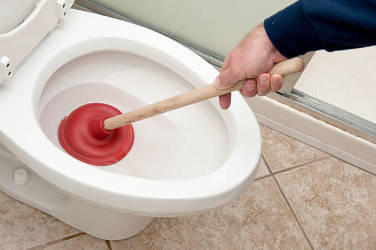
The most common method to unblock a toilet is with the use of a toilet plunger. A toilet, or flange plunger, uses suction and compression to dislodge clogs in a toilet. When you seal the plunger over a drain opening and push down on it, water and the clog are forced downward, starting the process of loosening the blockage. When you pull up on the plunger, the water in the drain is pulled upward, moving the blockage in the other direction. This push-pull action loosens the clog and moves it away from the walls of the pipe, resulting in it passing through the drain.
To unblock a toilet with a toilet plunger, follow these steps:
- Get a toilet plunger
A toilet plunger differs from a sink plunger. Toilet plungers have a sleeve-like extension, the flange, on the bottom of the cup. The flange fits into the hole of the toilet bowl for a good seal.
- Make sure there is water in the toilet bowl
If there is no water in the toilet you will need to fill it with some. Fill it with enough water to submerge the head of the plunger.
- Position the plunger
Make sure that the flange of the plunger is pulled out of the cup (see image). Now lower the plunger at an angle into the opening at the bottom of the bowl. The point of lowering it at an angle is to ensure the cup fills up with as much water as possible. If you trap a lot of air in the cup, it will reduce the force at which the water will be plunged.
- Start plunging
Now that the flange is inside the hole and the cup is over the drain hole, you can start plunging. Hold the plunger’s handle with two hands and forcefully push down on the cup and pull back up.
Push and pull continuously around five or six times, then pull the cup off the hole after the last pull. This rapid change between compression and suction in the toilet drain should loosen the clog.
If water gushes out of the side of the cup, then you haven’t created a proper seal around the hole. Reposition the plunger and start plunging again.
- Flush the toilet
Now’s the time to see if the blockage has cleared. Flush the toilet. If the water drains as normal, then the toilet is unclogged and all is well again.
If the water drains slowly or doesn’t drain at all, then the blockage is still present and will still need unclogging. If this is the case, repeat these steps again a few more times.
If after attempting this method two or three times, the blockage does not clear, try using the following method.
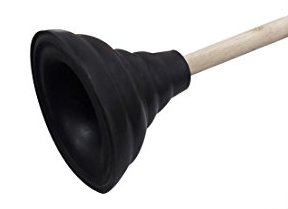
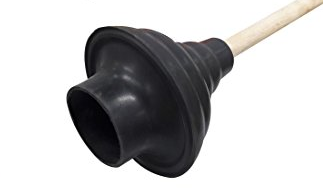
Use a toilet auger
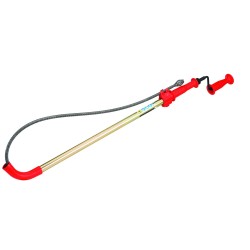
The pipe system in a toilet is long and bendy, so if you have a blockage located deep in the system that won’t budge with the use of a plunger, a toilet auger will be your best bet.
A toilet auger, or plumbing snake, is a 3 to 6 foot flexible cable with a coiled head and a cranking handle that is used to unclog toilets. It works by breaking up the clog or pushing it through the drain.
To unblock a toilet using a toilet auger, follow these steps:
- Insert the auger
Slowly insert the coiled end of the auger into the toilet bowl and down the hole into the pipe.
- Lower the cable
Hold the main part of the auger with one hand and push down on the handle with the other. Pushing down on the handle will feed the cable into the pipework.
- Start cranking
Continue pushing down on the auger whilst turning the handle clockwise. This will help push the cable further through the pipework. Crank the handle until it has been pushed all the way down.
- Dislodge the blockage
Once you have cranked the auger all the way down, the blockage should now have been pushed through the system and out the other end.
- Retrieve the auger
Now that the handle of the auger is all the way down, the auger has been fully extended. It is now time to retrieve it. Pull the handle back up all the way. This will pull the cable back to its original position at the end of the auger.
- Flush the toilet
With the end of the auger still inside the toilet bowl, flush the toilet. This is to wash away any debris that might be on the auger and to flush the broken up pieces of the blockage away.
If the toilet flushes as normal, you have successfully cleared the blockage. If it doesn’t, then you should attempt these steps again, as the blockage might need a bit more loosening before it clears.
If you don’t have a plunger or toilet auger, the next few steps will show you how to unblock a toilet with common household items.
Use a coat hanger
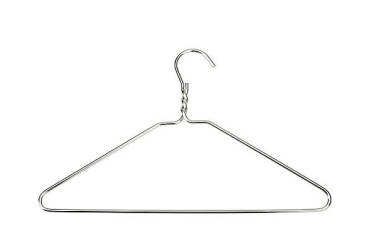
This method works similar to the auger method. The purpose of using a coat hanger is to reach the obstruction and either push it down or pull it out.
To unblock a toilet using a coat hanger, follow these steps:
- Get a coat hanger and unwind it until it is straight.
- Bend one end of the hanger into a U shape.
- Insert the U end of the hanger into the waste outlet at the bottom of the toilet bowl.
- Feed the hanger through the toilet until you feel the blockage.
- Continuously push and pull the hanger to break up the blockage until you notice the water draining away.
- If you have pushed and pulled at the blockage for a while and haven’t noticed the water draining, pull the hanger back out. Some of the blockage might have been caught on the end of the hanger.
- If you have pulled the hanger out and the toilet is still blocked, you may have helped to push the blockage down or at least broken it up a bit. Trying the next method might help to get rid of the blockage once and for all.
Washing up liquid
It may be surprising to learn that washing up liquid may be able to unblock a toilet. Washing up liquid can be used to lubricate the drain and help loosen up the clog. It can also help dissolve some materials that may be clogging the toilet.
To unblock a toilet using washing up liquid, follow these steps:
- Pour half a cup of washing up liquid into the toilet bowl.
- Leave it for 30 to 45 minutes to allow it to loosen and dissolve the clog.
- After you have waited 30 to 45 minutes, fill a bucket with hot water and pour it into the toilet from waist height. The force of the water should help to dislodge the blockage.
- The toilet may still be blocked, but hopefully the pressure of the water is now helping the clog work its way through the drain, which has now been lubricated by the washing up liquid.
- After around 10 minutes, flush the toilet. Hopefully the blockage will have been cleared.
- If the toilet is still blocked but you notice the water level is dropping, then it is a sign that the blockage is loosening or dissolving as some water is now able to pass through the drain.
- If the blockage hasn’t passed, repeat the process one more time.
Baking soda and white vinegar
If you tried to unblock a toilet using the washing up liquid method and it didn’t clear the obstruction but you saw signs that it was working, i.e. the water level was dropping, then you should add baking soda and white vinegar to the process.
Baking soda and vinegar will help to dissolve materials such as tissue, sanitary towels, cotton balls, etc, that may be causing the blockage.
To use baking soda and white vinegar to unblock a toilet, follow the washing up liquid method but add a cupful of baking soda and white vinegar. The washing up liquid will help loosen the blockage while the baking soda and vinegar will help to dissolve it.
Use a plastic bottle
This method works to unblock a toilet by using pressure to dislodge the blockage. As well as wearing old clothes, it's a good idea to wear a mask and eye protection while carrying out this method.
To use a plastic bottle to unblock a toilet, follow these steps:
- Put on a pair of rubber gloves and remove as much water from the toilet bowl as possible. You can do this by repeatedly filling a small container and pouring the water out into a bucket.
- Fill a large plastic bottle with warm water.
- Keep your thumb over the top of the bottle and insert the top of the bottle into the outlet at the bottom of the toilet.
- Remove your thumb and squeeze the bottle so that the water shoots out down the toilet drain. The pressure should dislodge the clog.
- Pour some water into the toilet bowl, if the water level goes down, the clog has cleared.
- If the water level does not go down, repeat the process again one or two more times.
How to prevent blockages
- Address slow drains
If you flush your toilet and you notice the water is draining slower than usual, investigate the issue immediately, before a full blockage occurs. Use the methods outlined in this article to get rid of partial blockages.
- Keep the area above your toilet clear
Having a shelf above your toilet might be handy to keep extra toilet paper, soap, ornaments, etc, but these items can easily be knocked into the toilet and cause a clog.
- Know what is and isn't flushable
A lot of people flush materials down the toilet without realising they could contribute to a blockage forming. If you flush materials such as sanitary pads, baby wipes, fats and oils, diapers, etc, they will sit in the waste pipe and block other materials from draining away.
Make sure everyone in your household knows what can and can not be flushed down the toilet
- Clean your toilet regularly
Not only will cleaning your toilet regularly keep it hygienic, but it could also help to loosen potential blockages. The chemicals in bleach, washing up liquid, etc will help to lubricate the drain and help clogs slide down easier. Using the washing up liquid, baking soda, and vinegar method previously mentioned in this article is a good way to keep your toilet clean and to unclog blockages.
What should I do if my toilet is still blocked?
If you have taken the steps outlined in this article but your toilet is still blocked, then it is time to call in a professional to get to the bottom of the issue. Get in touch with us today to see how we can help with your home's plumbing issues
Avoid unexpected costs.
With a Smart Plan cover policy, you can rest easy knowing if there's an issue with your plumbing, we'll usually have you back up and running within 48 hours.

